

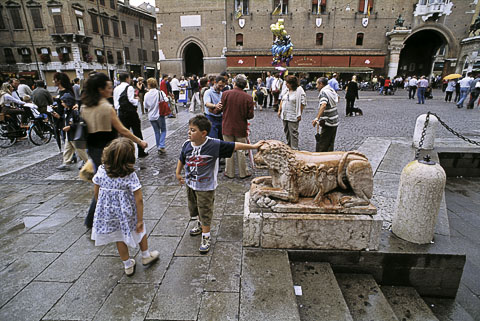
Piazza Trento e Trieste, Ferrara, Italy


2002 J.Crawford
In the last article we turned to the question of where to begin carfree conversions and how to increase density in the carfree areas. The strategy was simple and obvious: start at the transport halts and gradually expand the carfree areas as alternatives to cars and trucks become readily available. We also considered how to increase the density of building construction. This matter is specific to any given city, but the methods are simple: make streets narrower and reclaim the space for buildings.
In this final installment, we examine two matters that might be called the carfree gravy: more and better public spaces, and new and expanded green areas in or near the city. We will consider public space first.
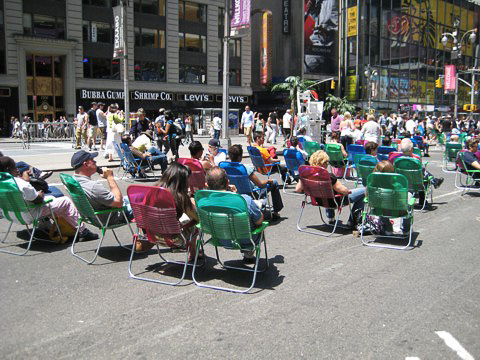
A hasty conversion of a major thoroughfare to a carefree space
Near Times Square, summer 2009


©2009 Mark Fleischmann
Improving Public Squares
Most cities today lack a sufficient number of high-quality squares, or plazas, if you prefer. Many cities have them, but they are overwhelmed by the roar of traffic passing through or around them. Once the cars are gone, little needs to be done to improve these spaces and return them to civic uses. As we saw when cars were taken out of Times Square in New York, minor improvements to the space were conducted very quickly and at little cost. This square, long one of the most vibrant spaces in New York, has improved dramatically in quality. Even so, Times Square is still adversely affected by heavy traffic on the cross streets and where Broadway crosses 8th Avenue.

Campo San Bartolomeo, Venice


2001 J.Crawford
As we push cars out of the centers of our cities, we will find that many squares will enjoy a new lease on life. We should be prepared to spend small amounts of money to improve the paving (i.e., tear up the asphalt and replace it with something prettier) and provide street furniture suitable to the new uses.
Squares and their uses were taken up at great length in Carfree Design Manual. I'll very briefly summarize a few main points here.
- Pay attention to sun and wind when considering the functioning of squares and possible improvements
- There are different kinds of squares; pay attention to existing and potential uses when rearranging squares post-car
- Squares live or die by their furnishings; be sure to add the amenities that will draw people in
- Add fountains and wading pools if at all possible
- Try to add sidewalk cafes in most squares, even quite small ones
- Add life to squares by encouraging street performers in at least some of the more active ones
- Allow food carts in most or all squares
- If a square is too big, add a high-quality public building to soak up the excess space
- Do not be too hasty to add greenery to squares, but trees are often a welcome addition
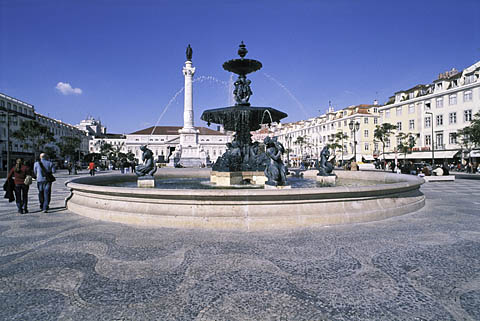
Fountain, Praça do Rossio, Lisbon


2003 J.Crawford
None of these measures is difficult to implement, and there is a growing body of knowledge regarding the functioning of urban public space. Be sure to consult the literature or experts for advice. Be prepared to adjust the spaces if the first attempts are not entirely successful.
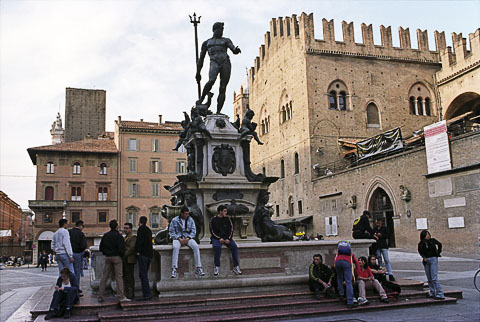
Fountain of Neptune, Piazza Maggiore, Bologna


1998 J.Crawford
Public safety was more or less taken as a given in Carfree Design Manual, and carfree areas tend to be naturally crime-resistant. This is especially true if the adjacent buildings are occupied around the clock, which provides plenty of eyes on the street. Whatever the case, criminal activity must not be allowed to gain a toe-hold, as that can rapidly destroy the best public spaces, as happened to New York's wonderful Bryant Park for a couple of decades. Most squares that are too big to draw quite a few people during the evening should be made smaller. Desolate squares are a magnet for criminal activity.
The new and improved squares should lead quickly to a better quality of life for the city's residents. Over a longer span of time, the improved social cohesion in the city should lead to a significant strengthening of social cohesion.
Adding Green Space
Considering green space from the perspective of contemporary US cities, it is apparent that the more central areas consist almost entirely of highways, streets, parking, and buildings. At best there may be a few trees and small parks. Just beyond the downtown core, most US cities shift to one or another form of suburb. The oldest, closest suburbs will usually be the most dense and have well grown-in trees and greenery. The newest, most distant suburbs will usually have larger houses on much larger lots, with the trees still mere saplings. In all of these cases, this green space is privately owned and maintained. It can be attractive, but it serves the functions of a park only for the family that owns it, and generally poorly at that. These are social spaces only for the family and their guests. They are not shared space, nor are they in any sense wilderness.
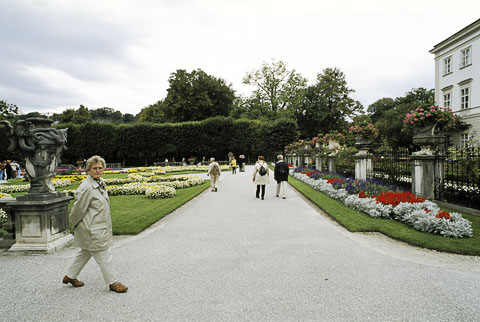
Mirabellgarten, a formal park, Salzburg


2002 J.Crawford
Most suburban areas do have parks, and some of these are quite large. Many are densely wooded and may have streams and ponds. However, except for a fortunate few who live nearby, they are most easily accessed by car. As car traffic declines, more people will be able to reach these parks safely and comfortably by bike.
However, in suburbs undergoing conversion to the carfree model, parkland is really just a part of a larger problem: these areas are laid out in a fundamentally non-functional manner. Everything, including the parks, is allocated to one specific use. This results in having to drive somewhere for nearly every activity. In addition, the population density of the inhabited areas is too low to support good public transport.
Therefore, the reshaping of American-style suburbs will result in a wholesale redevelopment of these areas over a span of decades. Rearranging open space will of course be a major part of this process. In fact, the inhabited land area will in most cases decline quite significantly as its density increases several-fold. This will free up a great deal of land for other uses. Given that the supply of transport fuel will become steadily more problematic, it makes sense to grow perishable foods, which consume the most transport energy, as close to every city as circumstances permit.
This leads us to the question of which parcels of open land should be made into parks and which should be allocated to other uses. The answer is generally simple. The land nearest the built-up areas should be made into parks because it is the quickest for residents to access and sees use by the greatest number of people. Rather than having a few large parks, many small parks should be established, so that a park is within walking distance of almost everyone. The category "parks" includes playing fields and other managed outdoor areas dedicated to recreation and fitness.
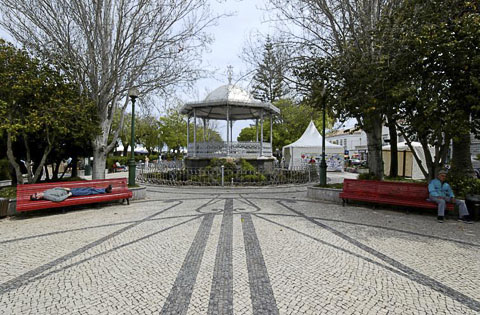
Praça da República, a nicely furnished urban park, Tavira, Portugal


2005 J.Crawford
Not all green space should be parks or playing fields; leave most of it for working farms, woodland, wetlands, and so forth. Children especially benefit from ready access to green space with a variety of functions. It is from this that they learn much about how nature functions, and there is increasing evidence that children crave direct contact with natural environments. Be sure to make this available to them, and, not incidentally, to their parents.
But what of the dense downtown cores that currently lack open space? Some of the broad streets can be made into boulevards. This will reduce the number of traffic lanes and allow the planting of trees, but the remaining road capacity will be more than adequate. This arrangement is especially suitable to the streets along which trams will operate. It will take decades for the trees to grow in, but the relief from the noise, stink, and danger of cars is immediate.
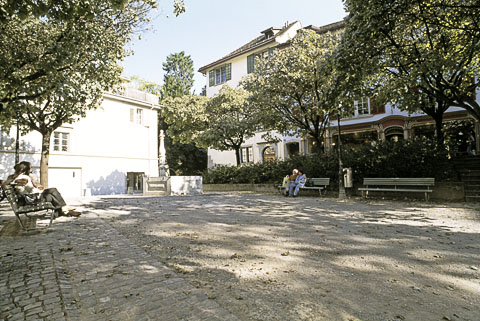
Pocket park, Zürich


2002 J.Crawford
Surface-level parking lots can be turned quite easily into mini-parks, and their natural distribution would place a lunch-time pocket park within walking distance of nearly every workplace. Multi-story parking structures will be difficult to reuse, and most will probably be torn down. Good riddance.
When siting parks, try to resist the temptation to place them in the center of the city, near public transport halts. This is precisely the land that should be most densely developed because of the proximity to transport. Low-intensity uses, including parks, need to be situated at the limit of walking distance from the transport halts. In most cultures, this will be about 2500 feet (say 750 meters).
Always reclaim waterfronts. These make by far the best parks, and people are always drawn to water. In some cities, elevated highways along a riverfront have already been torn down, and this example should be followed as quickly as possible in every city. New York was transformed by the removal of the elevated West Side Highway, and the city was finally reunited with the broad Hudson River.
Conclusion
This concludes this series of six articles on the conversion of existing cities to the carfree model. We have not considered this matter in much detail until now because the pure case of new carfree cities is simpler to analyze. New carfree cities will doubtless be widely built in India and China, where rapid urbanization continues, with new cities sprouting every year. However, in the Western world, where populations are approximately stable, the carfree conversion must of necessity become the norm.
In all cases, the process will have to be governed by existing conditions. The Reference Design is a useful yardstick and offers solutions to many problems, particularly transport-related. However, in most cases, carfree conversions will diverge considerably from the Reference Design. This is no bad thing, so long as the one basic principle is observed: return the streets to human uses.
Achieving sustainability is the great task of the 21st century. This is the largest challenge ever faced by humanity, but it comes at a time when our knowledge and human resources are greater than ever. The conversion of existing cities and suburbs to the carfree model is one of the cornerstones of any plan to reach sustainability. Fortunately, this change also produces plenty of tasty gravy for our cities.
First published in CarBusters #42 (June-August 2010).
|